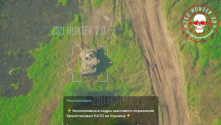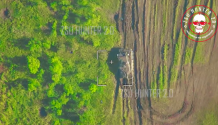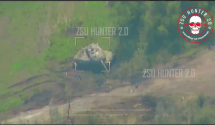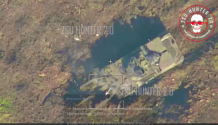Well, let's remember that the Russians most likely destroyed 5 of the Su-24s that Poland gave up that were carrying the missile while they were on base.Ukraine doesn't have enough aircraft for mounting Storm Shadow, basically only SU-24s can mount them and Ukraine doesn't have enough SU-24s.
The Russian group claims that the Ukrainians are bombarding their positions with M142,so the Ukrainians are already trying very hard.
You are using an out of date browser. It may not display this or other websites correctly.
You should upgrade or use an alternative browser.
You should upgrade or use an alternative browser.
The War in the Ukraine
- Thread starter SampanViking
- Start date
For real. This like 100~ vehicle lost in span of 2 days. There is no way it is an diversion. The much hyped counteroffensive has began for real for real.that comment is outdated, seeing the videos of the last 6-7 hours I would even say we are close to the 2 brigades gone.
Several countries pledged Leopard 2A6 or A5 to Ukraine.What feels off to me is the arrowhead armor. It indicates it is at least Leopard 2A5 model, or possibly higher. I have not heard of more advanced model than 2A4 being sent to Ukraine.
"As of late April, we have the following officially announced commitments, sorted by countries and modifications:
- Germany: 18 Leopard 2A6
- Portugal: 3 Leopard 2A6
- Sweden: 10 Leopard 2A5 (Strv 122)
- Poland: 14 Leopard 2A4
- Spain: 10 Leopard 2A4
- Norway: 8 Leopard 2A4
- Canada: 8 Leopard 2A4
- Netherlands and Denmark: 14 Leopard 2A4"
They got 14 A6sWhat feels off to me is the arrowhead armor. It indicates it is at least Leopard 2A5 model, or possibly higher. I have not heard of more advanced model than 2A4 being sent to Ukraine.
I am going to say it out loud for you. This is blatant racism. All the victory are by superior German engineering all the defeat are by inferior Slavic execution.
Na, the day of recon or deception is out of the question.For real. This like 100~ vehicle lost in span of 2 days. There is no way it is an diversion. The much hyped counteroffensive has began for real for real.
They may try to attack at other points, that's what they've been doing for the last 4-5 days of the offensive, but in that column they've lost about half their best tank.
The defence minister told a press conference: "If Russia changes its terms, we can negotiate a peace".
Well, in the next week we will know for sure.
Europe is likely to withdraw its support, there is simply nothing more to give to Ukraine.
Will be interesting to see how many left in two weeks... The challenger mbt are not in battle yet.Several countries pledged Leopard 2A6 or A5 to Ukraine.
"As of late April, we have the following officially announced commitments, sorted by countries and modifications:
- Germany: 18 Leopard 2A6
- Portugal: 3 Leopard 2A6
- Sweden: 10 Leopard 2A5 (Strv 122)
- Poland: 14 Leopard 2A4
- Spain: 10 Leopard 2A4
- Norway: 8 Leopard 2A4
- Canada: 8 Leopard 2A4
- Netherlands and Denmark: 14 Leopard 2A4"
I was thinking they would go full yolo to Bahkmut where flanks look quite soft but they have gone south like they have said for the past 6 months...Still positives actions from Ukraine forces around Bakhmut but with forces not at the level of these ''probing'' in force. Will they change focus ?
Last edited:
Based on time of flight and speed of ATGM, assuming that's a Vikhr with speed of 600m/s and 23s time of flight that target is almost 15km away!
Almost all missiles have a short few seconds of boost to VMax and then after that, a glide phase where it bleeds velocity constantly.
VMax on the Vikhr is 610m/s
But ...
ToF to 4km = 9s VAvg(0-4km) = 444m/s
ToF to 6km = 14s VAvg(0-6km) = 429m/s, VAvg(4-6km) = 400m/s
ToF to 8km = 23s VAvg(0-8km) = 348m/s, VAvg(6-8km) = 222m/s
ToF to 10km = 35s VAvg(0-10km) = 286m/s, VAvg(8-10km) = 166m/s
So if your count of 23s is correct, that'd be 8km
Today's analysis by Mikael Valtersson, I quote:
Analysis Ukrainian counteroffensive Zaporizhia Juni 9
Hard fighting continues along the Zaporizhia front, but with no ukrainian breakthrough. Sometimes UkrAF makes small gains and then RuAF retakes the lost territories. But all fighting are still being conducted in the gray area in front of the russian main defence lines (map 3).
I will not go into details about attacks and counterattacks, but the main areas of fighting has been centred around Lobkove to the west, and Robotino to the south, of Orikhiv. Lobkove was captured a short while by ukrainian forces, but later they retreated due to intense russian bombardments.
In Robotino russian forces retreated to the second line of forward positions closer to the settlement, then russian forces retook the lost positions and presently ukrainian forces has taken them a second time and now russian forces try to retake the first line a second time. But still the ukrainians has not reached the settlement of Robotino and they are fighting an uphill battle in open terrain (see topographical map 2) through russian minefields and might have to withdraw a second time to their original positions.
The ukrainian forces doesn't seem to sweep mines in advance of the attack. They do it with a couple of mine clearing vehicles when they attack and behind them the ukrainian armour advance in a column that is an easy target for russian AT assets. In a way it resembles the russian armour columns in the beginning of the war. Columns that took catastrophic losses to ukrainan AT weapons, a history now repeated by the ukrainans.
In advance of an offensive, the attacking side must secure air and artillery superiority, so they can shield their mine clearing operations and troop concentrations. And at the same time destroy the defenders command structures and logistical hubs. Finally when they attack their air and artillery superiority can be utilised to severely hurt and slow down enemy reserves to secure breakthroughs. This becomes even more important if the enemy has large reserves and a defence in depth.
On the Zaporizhia front the situation is the opposite, so ukrainian forces hasn't many choices how to act. One method is to achieve strategic surprise as in the Kharkiv offensive last autumn. That option doesn't exist on the Zaporizhia front. In general I would say that an attack towards an enemy who has all the benefits RuAF has on the Zaporizhia front is suicidal.
The only way ukrainian (and western) commanders even could have contemplated that such an offensive could succeed was if 1, western weapons was much superior to russian weapons, 2, western trained soldiers much superior to russian soldiers and 3, russian morale was dismal. If all these factors where true, UkrAF might have had a chance to succeed, but nothing seems to corroborate those assumptions.
Many on the ukrainian and western side had anticipated hard initial resistance from RuAF, but after 2-3 days fighting and advances of around 6-8 km, they expected an increasing collapse of russian morale and the real breakthroughs would come. Nothing of this seems to be other than wishful thinking, since fighting still are in the grey zone and russian resistance are unbroken. At the same time ukrainian forces take heavy casulties both in soldiers and vehicles.
The offensive isn't over yet and the main ukrainian attack fist remains with probably over 600 tanks and as many IFVs around Orikhiv. But the future for the ukrainian offensive looks bleak if their vanguard is destroyed before they reach the russian main defencelines. The probability is large that Ukraine has to use up their main force to get through a couple of the russian defencelines and then they will run out of forces to exploit any successes and be forced to withdraw.
To summarise, the most likely outcome of the ukrainian offensive is minor territorial gains at a horrendous cost. As I've said before it seems to be Kursk 2.0
Analysis Ukrainian counteroffensive Zaporizhia Juni 9
Hard fighting continues along the Zaporizhia front, but with no ukrainian breakthrough. Sometimes UkrAF makes small gains and then RuAF retakes the lost territories. But all fighting are still being conducted in the gray area in front of the russian main defence lines (map 3).
I will not go into details about attacks and counterattacks, but the main areas of fighting has been centred around Lobkove to the west, and Robotino to the south, of Orikhiv. Lobkove was captured a short while by ukrainian forces, but later they retreated due to intense russian bombardments.
In Robotino russian forces retreated to the second line of forward positions closer to the settlement, then russian forces retook the lost positions and presently ukrainian forces has taken them a second time and now russian forces try to retake the first line a second time. But still the ukrainians has not reached the settlement of Robotino and they are fighting an uphill battle in open terrain (see topographical map 2) through russian minefields and might have to withdraw a second time to their original positions.
The ukrainian forces doesn't seem to sweep mines in advance of the attack. They do it with a couple of mine clearing vehicles when they attack and behind them the ukrainian armour advance in a column that is an easy target for russian AT assets. In a way it resembles the russian armour columns in the beginning of the war. Columns that took catastrophic losses to ukrainan AT weapons, a history now repeated by the ukrainans.
In advance of an offensive, the attacking side must secure air and artillery superiority, so they can shield their mine clearing operations and troop concentrations. And at the same time destroy the defenders command structures and logistical hubs. Finally when they attack their air and artillery superiority can be utilised to severely hurt and slow down enemy reserves to secure breakthroughs. This becomes even more important if the enemy has large reserves and a defence in depth.
On the Zaporizhia front the situation is the opposite, so ukrainian forces hasn't many choices how to act. One method is to achieve strategic surprise as in the Kharkiv offensive last autumn. That option doesn't exist on the Zaporizhia front. In general I would say that an attack towards an enemy who has all the benefits RuAF has on the Zaporizhia front is suicidal.
The only way ukrainian (and western) commanders even could have contemplated that such an offensive could succeed was if 1, western weapons was much superior to russian weapons, 2, western trained soldiers much superior to russian soldiers and 3, russian morale was dismal. If all these factors where true, UkrAF might have had a chance to succeed, but nothing seems to corroborate those assumptions.
Many on the ukrainian and western side had anticipated hard initial resistance from RuAF, but after 2-3 days fighting and advances of around 6-8 km, they expected an increasing collapse of russian morale and the real breakthroughs would come. Nothing of this seems to be other than wishful thinking, since fighting still are in the grey zone and russian resistance are unbroken. At the same time ukrainian forces take heavy casulties both in soldiers and vehicles.
The offensive isn't over yet and the main ukrainian attack fist remains with probably over 600 tanks and as many IFVs around Orikhiv. But the future for the ukrainian offensive looks bleak if their vanguard is destroyed before they reach the russian main defencelines. The probability is large that Ukraine has to use up their main force to get through a couple of the russian defencelines and then they will run out of forces to exploit any successes and be forced to withdraw.
To summarise, the most likely outcome of the ukrainian offensive is minor territorial gains at a horrendous cost. As I've said before it seems to be Kursk 2.0
Come on … but surely not from those locations where the Ukrainians are advancing.
My point is simply, that - like in a few other forums already happening - based the lack of imagery and report about advances and success as well as a destroyed IRIS-T radar and the Leo 2 to conclude the whole Ukrainian counteroffensive is a failure, Western systems are overhyped crap and so on is misleading at best.
Based on my understanding, the Ukrainians have a very strict no-news policy concerning the important locations and we all need to wait for more information.
Why don't you check this video which shows a Ukrainian soldier self vlogging and documenting himself at Lobkove. Oh now we know they were at Lobkove, past tense.
It is hard to say. People focus too much on the equipment but never on the training, military culture and organization. Assuming the footage of the wrecked Bradley’s and Leopards is real, one can argue that the losses were caused by the lack of combined arms training, knowledge and leadership along with various other variables such as the higher ups’ adherence to the old Soviet doctrine and, worst of all, lying in training which most likely translates into lying on the battlefield. All of this is mentioned by former US Special Forces officers who are in Ukraine training battalion and company officers as we speak in this article:
I read the aforementioned article a couple weeks ago when Kofman retweeted it actually. I am always interested in the opinions of NCOs and junior staff, but at the same time, lower-level officers tend to have a habit of being very narrowly Eurocentric (or maybe I should say NATO-centric?).
Doctrines evolve, tactics evolve, and so do combat manuals. Especially as they are meaningfully applied in the field, rather than officer halls. This is true of NATO as well. The failure in Vietnam has led to significant revisions in US manuals and an evolution in air power doctrine (among others). The same happened to the Red Army in the aftermath of its intervention in Afghanistan.
I don't think there is something inherently wrong with old Soviet style doctrine. Or something inherently wrong with NATO's, China's, or otherwise. Every military will have its gaps. What is important, is that a State's military power have a doctrine. That is has a cohesive way of war that can adapt and evolve to meet modern challenges.
The main issue with some of the way NATO has approached Ukrainian training, is that they are trying to re-create a new army, instead of simply improving on what's already there. They look down on older practices (ironically, one could argue that it was Soviet legacy equipment and mobilization infrastructure that saved Ukraine in its first three weeks) and try to reject everything in favor of "modernity" or Western style practices.
In my opinion, this is an error, and this approach has led to what Kofman described as two armies co-existing in one organization, which is clearly a source of friction and mis-communication in the army.
Instead, NATO trainers need to focus on cohesion, and improving on parts that are deficient, while maintaining or evolving the parts that work well. NATO's commentary and approach, is ironically reminiscent of the typical caricature of a Communist Commissar. Detached, and un-involved in the actual work, while passing down judgement on the people who actually do the work.




